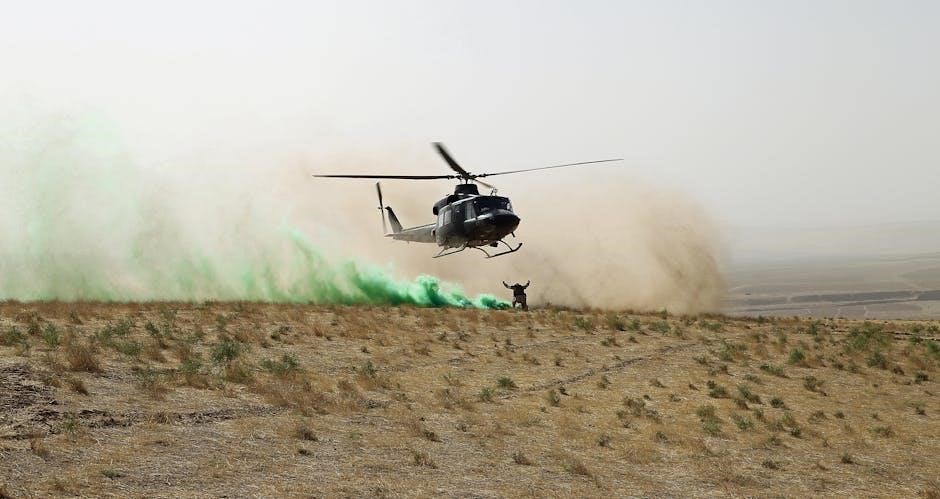Ground guide signaling is a method of communication using visual signals to direct vehicles and equipment safely, primarily in military and construction environments, ensuring efficient maneuvering and preventing accidents daily.
Importance of Ground Guide Signaling
Ground guide signaling is crucial for ensuring the safe movement of vehicles and equipment in various environments, including military bases, construction sites, and other areas where large machinery is operated. The use of standardized visual signals enables drivers to maneuver their vehicles efficiently and effectively, reducing the risk of accidents and injuries. Effective ground guide signaling also enhances operational effectiveness by allowing vehicles to move quickly and safely, which is essential in emergency situations or when working under tight deadlines. Additionally, ground guide signaling promotes a culture of safety and awareness among personnel, emphasizing the importance of clear communication and teamwork in preventing accidents and ensuring successful operations. By using ground guide signaling, organizations can minimize risks and maximize efficiency, making it an essential component of their safety protocols and operational procedures. Ground guide signaling is a critical aspect of safe vehicle operation.

Methods of Ground Guide Signaling
Standardized hand and arm signals are primary methods used for ground guide signaling daily everywhere.
Hand and Arm Signals
Hand and arm signals are a crucial aspect of ground guide signaling, used to communicate with drivers and direct vehicles safely. These signals are standardized and used by ground guides to convey important information. The use of hand and arm signals allows ground guides to provide clear and concise instructions to drivers, ensuring that vehicles are maneuvered efficiently and safely. In addition, hand and arm signals are used in conjunction with other methods, such as flashlights, to provide effective communication in various environments. The standardized nature of hand and arm signals ensures that all personnel understand the signals, reducing the risk of miscommunication and accidents. Overall, hand and arm signals play a vital role in ground guide signaling, enabling safe and efficient vehicle movement. They are an essential component of ground guide signaling, used to prevent accidents and enhance operational effectiveness.

Ground Guide Signaling Techniques
Ground guide signaling techniques involve using standardized methods to communicate with drivers and direct vehicles safely and efficiently every day always.
Use of Flashlights at Night
The use of flashlights at night is a crucial aspect of ground guide signaling, as it enables ground guides to communicate effectively with drivers in low-visibility conditions.
According to the information, a screened flashlight is the best method to ground guide a vehicle at night, as it provides a clear and visible signal to the driver.
This method is particularly important in environments where visibility is reduced, such as in darkness or in areas with heavy fog or smoke.
The use of flashlights at night is a standardized technique that is widely used in military and construction environments, where safety is a top priority.
By using flashlights, ground guides can ensure that drivers are aware of their signals and can maneuver their vehicles safely, even in challenging conditions;
Overall, the use of flashlights at night is an essential component of ground guide signaling, and is used to prevent accidents and ensure safe vehicle operations.

Ground Guide Responsibilities
Ground guides ensure safe vehicle operations, preventing accidents, and are essential for efficient maneuvering in various environments daily always.
Primary Ground Guide
The primary ground guide plays a crucial role in ensuring safe vehicle operations, as they are responsible for directing the driver and preventing accidents.
They must be clearly visible to the driver at all times, and their signals must be easily understood to avoid confusion.
In situations where there are multiple ground guides, the primary ground guide is the one from whom the driver takes their signals, and they must be able to communicate effectively with the driver.
If there is any confusion or the driver loses sight of the primary ground guide, they must stop the vehicle immediately to ensure the safety of the guides and prevent accidents.
The primary ground guide must be aware of their surroundings and be able to adapt to changing situations, making them an essential part of ground guide signaling.
Their role requires attention to detail, clear communication, and a focus on safety, making them a vital component of efficient and safe vehicle operations.

Ground Guide Signaling in Challenging Environments
Ground guide signaling is critical in challenging environments, such as congested areas, to ensure safe vehicle operations and prevent accidents daily always.
Use of Ground Guides in Congested Areas
Ground guides play a crucial role in ensuring safe vehicle operations in congested areas, such as motor pools, construction access sites, and assembly areas. The use of ground guides in these areas helps to prevent accidents and promote safe maneuvering. In congested areas, ground guides are essential to direct vehicles and equipment safely, preventing damage to property and injury to personnel. The proper use of ground guides in congested areas requires careful planning and coordination to ensure that all personnel are aware of their roles and responsibilities. By using ground guides in congested areas, organizations can minimize the risk of accidents and ensure that vehicles and equipment are operated safely and efficiently. This is particularly important in areas with heavy vehicle traffic, where the risk of accidents is higher. Effective use of ground guides in congested areas is critical to preventing accidents.

Be First to Comment